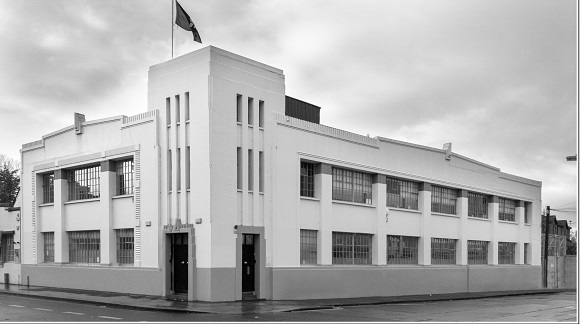This website uses cookies
This website uses cookies to enable it to function properly and to analyse how the website is used. Please click 'Close' to accept and continue using the website.



August 2019 - Kodak House, Dublin
Kodak House, Rathmines, Dublin by Donnelly, Moore and Keatinge (1930), with modifications by William Sedgewick Keatinge (1949-51)
The inner suburb of Rathmines, Dublin, is an area in flux. Once host to a mix of light industrial units and housing, it has now become a prestigious inner-city address. The Kodak Building or Kodak House, long a corner landmark site on Rathmines Road and Blackberry Lane, has itself followed that path. Designed in 1930 and built in 1932, it was the factory and warehouse for Kodak Ireland and is now the high-status home to an advertising agency. But the building itself, despite having its once-cream render painted white, still stands out against Dublin’s traditional red brick streets as if it were, to quote one commentator, “a stray project from Miami Beach that found itself cast adrift in Dublin”.
Kodak House is also slightly unusual in that Art Deco did not have a huge impact in Ireland, although the style had its moments in the new Republic. The Carlton and Savoy cinemas in O’Connell Street and Tivoli Cinema in Francis Street used Art Deco in the entertainment sphere, while Rathmines Post Office and the Transformer Station in Temple Bar, by Vincent Kelly, added Deco grandeur to public buildings.
As an image-conscious company – George Eastman, Kodak’s founder, encouraged ‘slipcover’ architecture that disguised the raw factory within – Kodak chose Donnelly Moore and Keatinge to deliver the building in the fashionable idiom. The firm designed a structure with horizontal steel fenestration embedded in concrete walls, and with a squat but imposing tower with vertical slit windows as its central feature: conjuring a sense of defensive space as well as abiding by the symmetrical classical language of pediment, pilaster and entablature.
Some of Kodak House’s machine-age ornamentation remains intact and apparent, such as the vertical lines on the tower, the zigzags facing the street, the strong lines leading to the parapet and the ziggurat-type finial: all expressing the rhythms of ‘Jazz Modern’ (a phrase still often used at the time of design). Made of concrete and supported by a steel structural grid, the building’s windows and plaster work have remained in good condition, and were revived with modifications by one of the original architects, William Sedgewick Keatinge in 1949-51.
Kodak sold the building to Quirke Lynch Limited in 1982, a company that continued the photographic processing business for almost two more decades. It was then refurbished by Paul Keogh Architects‘ in 1999 and became an advertising agency. While the exterior is faithful to the original there have been some interventions in the interior, such as a new roof offering greater natural light, and a mezzanine level within. But the renovation is considered a successful re-use, winning an RIAI Award and a Glen Dimplex Design Award in 2002. The original ungalvanised metal windows have been kept and renovated and Kodak House – as it is still widely known – is now a designated protected structure.
This month’s building is by architectural photographer Alan John Ainsworth, who also supplied the photograph.
Elain Harwood’s book Art Deco Britain is published this October. Keep your eye on our events for a lecture by Elain at our HQ and pre-order the book here.
Look for past Buildings of the Month by entering the name of an individual building or architect or browsing the drop down list.

Become a C20 member today and help save our modern design heritage.